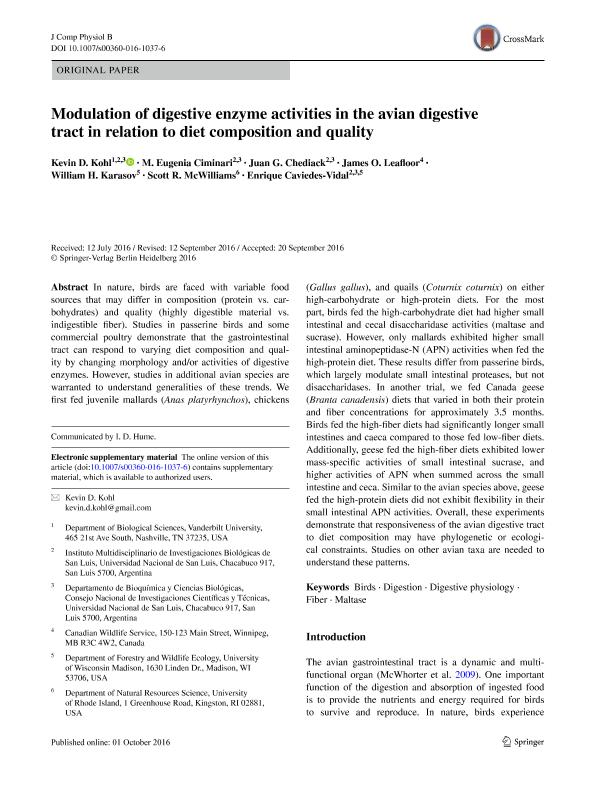Mostrar el registro sencillo del ítem
dc.contributor.author
Kohl, Kevin

dc.contributor.author
Ciminari, M. Eugenia
dc.contributor.author
Chediack, Juan Gabriel

dc.contributor.author
Leafloor, James O.
dc.contributor.author
Karasov, William

dc.contributor.author
McWilliams, Scott R.
dc.contributor.author
Caviedes Vidal, Enrique Juan Raul

dc.date.available
2018-09-21T20:17:32Z
dc.date.issued
2017-02
dc.identifier.citation
Kohl, Kevin; Ciminari, M. Eugenia; Chediack, Juan Gabriel; Leafloor, James O.; Karasov, William; et al.; Modulation of digestive enzyme activities in the avian digestive tract in relation to diet composition and quality; Springer Heidelberg; Journal of Comparative Physiology B: Biochemical, Systems and Environmental Physiology; 187; 2; 2-2017; 339-351
dc.identifier.issn
0174-1578
dc.identifier.uri
http://hdl.handle.net/11336/60662
dc.description.abstract
In nature, birds are faced with variable food sources that may differ in composition (protein vs. carbohydrates) and quality (highly digestible material vs. indigestible fiber). Studies in passerine birds and some commercial poultry demonstrate that the gastrointestinal tract can respond to varying diet composition and quality by changing morphology and/or activities of digestive enzymes. However, studies in additional avian species are warranted to understand generalities of these trends. We first fed juvenile mallards (Anas platyrhynchos), chickens (Gallus gallus), and quails (Coturnix coturnix) on either high-carbohydrate or high-protein diets. For the most part, birds fed the high-carbohydrate diet had higher small intestinal and cecal disaccharidase activities (maltase and sucrase). However, only mallards exhibited higher small intestinal aminopeptidase-N (APN) activities when fed the high-protein diet. These results differ from passerine birds, which largely modulate small intestinal proteases, but not disaccharidases. In another trial, we fed Canada geese (Branta canadensis) diets that varied in both their protein and fiber concentrations for approximately 3.5 months. Birds fed the high-fiber diets had significantly longer small intestines and caeca compared to those fed low-fiber diets. Additionally, geese fed the high-fiber diets exhibited lower mass-specific activities of small intestinal sucrase, and higher activities of APN when summed across the small intestine and ceca. Similar to the avian species above, geese fed the high-protein diets did not exhibit flexibility in their small intestinal APN activities. Overall, these experiments demonstrate that responsiveness of the avian digestive tract to diet composition may have phylogenetic or ecological constraints. Studies on other avian taxa are needed to understand these patterns.
dc.format
application/pdf
dc.language.iso
eng
dc.publisher
Springer Heidelberg

dc.rights
info:eu-repo/semantics/openAccess
dc.rights.uri
https://creativecommons.org/licenses/by-nc-sa/2.5/ar/
dc.subject
Birds
dc.subject
Digestion
dc.subject
Digestive Physiology
dc.subject
Fiber
dc.subject
Maltase
dc.subject.classification
Otras Ciencias Biológicas

dc.subject.classification
Ciencias Biológicas

dc.subject.classification
CIENCIAS NATURALES Y EXACTAS

dc.title
Modulation of digestive enzyme activities in the avian digestive tract in relation to diet composition and quality
dc.type
info:eu-repo/semantics/article
dc.type
info:ar-repo/semantics/artículo
dc.type
info:eu-repo/semantics/publishedVersion
dc.date.updated
2018-09-20T13:37:57Z
dc.identifier.eissn
1432-136X
dc.journal.volume
187
dc.journal.number
2
dc.journal.pagination
339-351
dc.journal.pais
Alemania

dc.journal.ciudad
Heidelberg
dc.description.fil
Fil: Kohl, Kevin. Vanderbilt University; Estados Unidos. Universidad Nacional de San Luis. Facultad de Química, Bioquímica y Farmacia. Departamento de Bioquímica y Ciencias Biológicas; Argentina
dc.description.fil
Fil: Ciminari, M. Eugenia. Universidad Nacional de San Luis. Facultad de Química, Bioquímica y Farmacia. Departamento de Bioquímica y Ciencias Biológicas; Argentina
dc.description.fil
Fil: Chediack, Juan Gabriel. Consejo Nacional de Investigaciones Científicas y Técnicas. Centro Científico Tecnológico Conicet - San Luis. Instituto Multidisciplinario de Investigaciones Biológicas de San Luis. Universidad Nacional de San Luis. Facultad de Ciencias Físico Matemáticas y Naturales. Instituto Multidisciplinario de Investigaciones Biológicas de San Luis; Argentina
dc.description.fil
Fil: Leafloor, James O.. Canadian Wildlife Service; Canadá
dc.description.fil
Fil: Karasov, William. University of Wisconsin; Estados Unidos
dc.description.fil
Fil: McWilliams, Scott R.. University of Rhode Island; Estados Unidos
dc.description.fil
Fil: Caviedes Vidal, Enrique Juan Raul. Consejo Nacional de Investigaciones Científicas y Técnicas. Centro Científico Tecnológico Conicet - San Luis. Instituto Multidisciplinario de Investigaciones Biológicas de San Luis. Universidad Nacional de San Luis. Facultad de Ciencias Físico Matemáticas y Naturales. Instituto Multidisciplinario de Investigaciones Biológicas de San Luis; Argentina. University of Wisconsin; Estados Unidos
dc.journal.title
Journal of Comparative Physiology B: Biochemical, Systems and Environmental Physiology

dc.relation.alternativeid
info:eu-repo/semantics/altIdentifier/doi/http://dx.doi.org/10.1007/s00360-016-1037-6
dc.relation.alternativeid
info:eu-repo/semantics/altIdentifier/url/https://link.springer.com/article/10.1007%2Fs00360-016-1037-6
Archivos asociados
